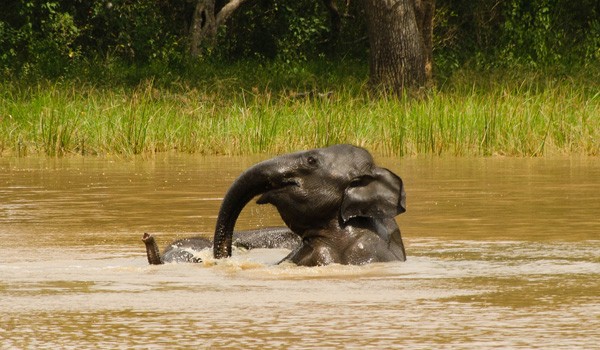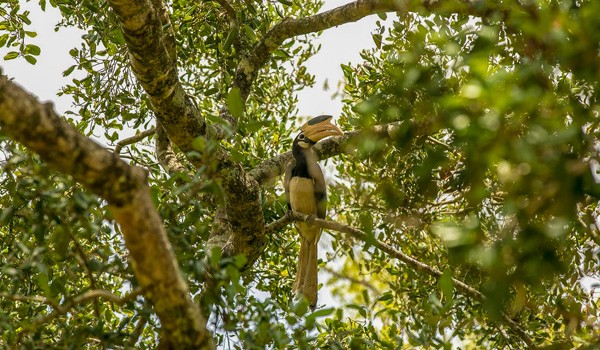Udawalawe National Park lies between the wet and the dry zones of Sri Lanka just below the central highlands and approximately 165km from the capital of Colombo. Surrounded by a large reservoir, this is one the most picturesque parks and home to large herds of Sri Lankan Elephants. It is easily accessible from the central highlands and remains popular with visitors.
Approximately 30,000 hectares in size, Udawalawe National Park was declared in 1972 as a refuge for animals following the construction of Udawalawe reservoir. It later became a sanctuary for water birds and elephants. In 1995 with the opening of the Elephant Transit Home, the park became even more popular due to the reintroduction of elephants into the wilderness. The park generally receives rainfall between October and January and again between March and May. The rest of the year remains dry. The average temperature is around 27°C-28° C. It is dominated by plains and grasslands with surrounding marshlands and the Kalthota mountain range to the north. This topography makes Udawalawe National Park an ideal habitat for elephants and waterbirds. Recorded figures show 184 species of birds including 33 migratory birds in the park. Forty-three mammals including the rusty spotted cat, fishing cat, and Sri Lankan leopard live in the park.

While sightings of elephants are almost a guarantee, sightings of other smaller mammals are hard and rare. The park provides habitat for endemic birds including Sri Lankan spurfowl, red faced malkoha, Sri Lankan grey hornbill plus a diverse group of waterbirds including painted storks, cormorants and spot-billed pelicans. The open nature of the park attracts a number of birds of prey including crested serpent-eagle, changeable hawk-eagle and white-bellied sea eagle. The area surrounding the park consists of small villages engaged in chena cultivation (slash and burn cultivation) which is a popular method in this region due to dry climatic conditions. Such cultivation existed prior to declaration of the national park. As such the authorities remain vigilant of encroaching and illegal hunting. Today, due to increased visitations to the park/touristic activities, more villagers, especially the younger generation, tend to focus on occupations related to tourism rather than cultivation.

However, you are likely to come across slash and burn cultivations and small stalls selling produce from such cultivation by the side of the main road to the park, particularly when travelling from the central highlands. For sightings of Sri Lankan elephants Udawalawe National Park remains the most popular destination as a sighting of an elephant is almost guaranteed in every single safari. The park is great for birders as the reservoir and marshland attract waterbirds and migratory birds alike. November to April is a good time for birders to visit the park due to increase number of migratory birds from Europe, North Africa and South Africa. These include birds of prey such as booted eagle and common kestrel. You are also likely to come across black-capped kingfisher, western yellow wagtail and forest wagtail during this season.

Jeep safaris are popular into Udawalawe National Park. While a few 4WD Toyota’s are used for safaris the average jeep is basic with most service providers using front-opened jeeps for good viewing. These jeeps assist good open views for photography especially considering the herds of elephants which tend to get quite close to the jeeps or cross the road in front or behind. In general, the elephants in this park are used to humans and tend to be easy going unless an aggressive single elephant in musth crosses the path or a mother with calves feels threatened. Each jeep is accompanied by an experienced park ranger. The safaris last 3-4 hours. Morning safaris commence ta 6.00 a.m. at the park entrance and the evening safaris commence at around 2.30 p.m. – 3.00 p.m. The park closes for visitors at 6.00 p.m. The park remains simple yet picturesque especially around the water bodies where picnic breakfast or tea/coffee is served on safari.

Accommodation is limited in this area. There is a handful of mid-range to comfortable accommodation options including tented camps. Of a number of safaris we have taken in this park the most unique encounter was seeing a herd of elephants crossing a grassland and main road while a bull elephant held the tail of female elephant – presumably asking for her ‘hand (rather tail) in marriage’. While we astonishingly stared at this special moment, our naturalist educated us that this is common as the bull elephant has to win the heart of the female and show affection in ‘public’ to obtain the permission of the matriarch. Interesting indeed! Udawalawe National Park remains quite central to most travellers. It is easily reachable from the central highlands and the south coast. It is a two- hour drive from Ella, 1.5 hours to Tangalle on the south coast and an hour drive to Yala National Park.

Here are sample itineraries for wildlife tours of Sri Lanka featuring Udawalawe National Park. Click below to read more about any of these safaris in Udawalawe or get in touch to receive a detailed, tailor-made itinerary.
This 16 day private tour itinerary has been specia...
16 Days/15 Nights
Secret Lives of Elephants in Sri Lanka
Read MoreCan’t recommend Chamee highly enough. Chamee particularly added to our Sri Lankan experience showing us some of the gems of your country. We felt safe and secure in his company and he was a very good man.’’ Praise for our drivers.